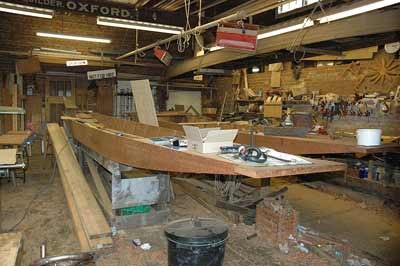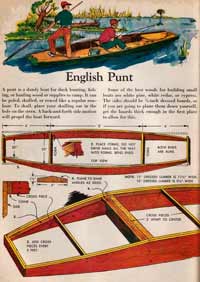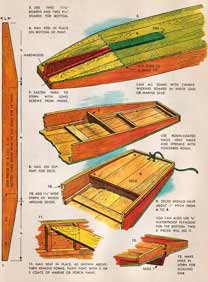
Punts

In this page a PUNT is a shallow draft boat with square ends and straight sides. Front and back of the boat show moderate rocker while the middle has a flat bottom. It is absolutely flat on top with no rocker. Essentially an elongated thin box with the bottom curved at the front and back. Often front and back of the punt are exactly the same shape although the inside might be different. Seen from the top, a punt might narrow at the front and back. Sometimes a punt has a perfectly square top view.
Propelling a Punt
Many different ways of moving a punt forward have been used. In Cambridge and Oxford and elsewhere in England, the punt is moved forward using a long pole. A great deal of argument exists as to correct technique of punting. The above punt diagram is shown as a Cambridge style. In Oxford the Bow and Stern would be reversed and the punter would stand not on the till but in the boat.This pole was originally made of spruce wood but now aluminium and composites can be found. The pole has the advantage of propelling the punt in narrow areas. It is not uncommon for a paddle to be used along with the pole, but not while racing.
Elsewhere in the world, punts have been propelled with oars, a sculling oar, paddles and even modified versions have been developed for sail.
Motors have been used successfully and punts can be made to plane if the shape of the bottom is appropriate for planing.

Uses of Punts
Photo of Punt in front of Kings College by Andrew Dunn. Punts are shallow draft and allows surprisingly heavy loads to be carried. Punts have been used in rivers or quiet water by fishermen and water fowl hunters. Punts have also been used to move freight again in shallow waters where other boats might come aground. Low freeboard and blunt sides make punts unsuitable when waves come up so punts were never really used in ocean settings.
Crude punts were used as utility boats by loggers who moved log rafts down rivers. Once the rafts had been delivered the punts were sold off.
In England, punts are extensively used and raced by college teams. They also exert a great fascination for tourists who rent the crafts and go careening around surprised by the level of skill required to move the punts safely.

Punt Construction
In its most basic form, the punt (sometimes called scow) is nothing more than a few boards nailed together. Its been made by boatbuilders for ages as a quiet water fishing and utility boat. In its more sophisticated form the punt becomes a lovely craft showcasing exotic woods and sporting careful workmanship
Although solid wood is the traditional way of building punts, modern builders have used plywood, and fiberglass models exist.
Modern plywood construction methods such as stitch and glue or chine logs have been substituted for the more traditional boatbuilding methods.


Free Punt Plans
The plans come from a very old book that has been in my family for as long as I remember. It has long lost cover and any identification page. The construction is simple and could be adapted for plywood with no difficulty. The plans suggest caulking the gaps with wicking and white lead. Don't do this. Lead is nasty and poisonous! Otherwise the plans are usable and I've tried to make it as legible as possible
email me if you find mistakes, I'll fix them and we'll all benefit: Christine
Punt Links
Punting in Cambridge
Flat bottom swamp boat
Punt trip company in Cambridge England
Michael Storer's punt design plans from Duckworks
St Mary's (Nova Scotia) Riverboat punt, offer free plans. pdf file
My Boatbuilding resources and links including suppliers, plans, boatbuilding methods and links to many blogs and boatbuilders diaries.
My Boat Plan page of boatbuilding plan links
Marine Plywood Grades used in Boatbuilding
Stitch and Glue boatbuilding method.
Take apart and folding boats.
Many one sheet punts have been built in plywood. Here is my page on building a boat using only one sheet of plywood.
Small Print
I don't claim to be an expert, I'm a fan though. If you want to build one do your homework first.